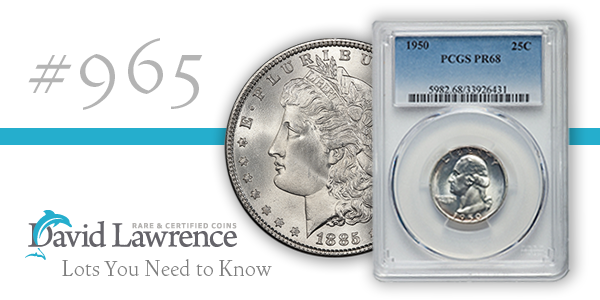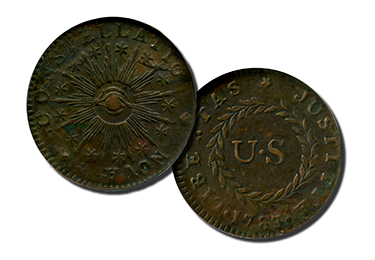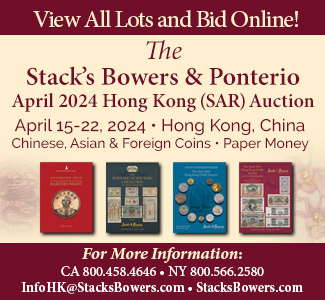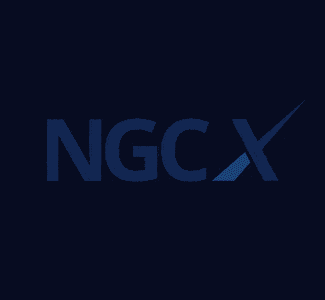
By CoinWeek …..
David Lawrence Rare Coins (DLRC) conducts online auctions of certified coins, offering collectors a mix of classic and modern material in all grades so that the everyman collector and the ultra-high-end registry set builder has the opportunity to upgrade their collections with new coins each week. Auction 965 is live now with 353 lots of PCGS- and NGC-certified coins, many offered with no reserve. All lots begin closing at 8pm EST on Sunday, June 18.
CoinWeek’s editors have studied the offerings and present the following lots you need to know.
Lot 8001: 1783 Nova Constellatio NGC AU50 BN (Pointed Rays, Large US)
When you hold a Nova Constellatio pattern in your hands, you are holding the first attempt of a national coinage on the part of the newly-formed United States of America. It would take another nine years and the formation of a new constitutional form of government, before the United States would be able to stabilize its national monetary system. Numismatists call the proposed coins and related issues struck in the period between the signing of the Declaration of Independence and the Coinage Act of 1792 “Post Colonial” issues.
 In terms of design, these issues run the gamut, from idolizing Continental Army commander and future president George Washington, to the mystical “all seeing eyes amongst a glory of stars” that makes up the obverse of the Nova Constellatios, to the downright weird “Janus” copper halfpenny dated 1776 (tell us it’s not creepy). The price range for these issues in AU or better starts at about a thousand dollars and proceeds up into a million plus for the rare Brasher doubloon. The current piece is one of the most affordable types of the period and should probably be part of the early copper segment of your collection.
In terms of design, these issues run the gamut, from idolizing Continental Army commander and future president George Washington, to the mystical “all seeing eyes amongst a glory of stars” that makes up the obverse of the Nova Constellatios, to the downright weird “Janus” copper halfpenny dated 1776 (tell us it’s not creepy). The price range for these issues in AU or better starts at about a thousand dollars and proceeds up into a million plus for the rare Brasher doubloon. The current piece is one of the most affordable types of the period and should probably be part of the early copper segment of your collection.
To date, NGC has reported 42 total grading events for the issue. In AU50BN, the population is four, with four in AU53BN and just two in Mint State. The current piece is mostly centered on the flan and has a nearly complete eye in the center of the coin. Weakness of strike, which is characteristic of coins of this vintage, can be seen on the lettering, but the devices and dates are clearly legible. It is our opinion that the present piece would benefit from a crack out and expert conservation, but the base coin is lovely and has plenty of character for a 230+ year old piece of copper.
Lot 8015-8033: Indian Head Cents, Especially Lot 8027
If you are building a certified Indian Head cent set, you may want to multi-tab browse the Indian section of the sale. There are some nice Civil War pieces (1862-1865 is represented) in near gem to gem grades. The Civil War date and type set is a great intermediate level focus area in silver and minor denominations. The degree of difficulty ramps up dramatically when you add mint marks and gold to the mix (see our series of articles over at PCGS if you want to make a serious go at it… warning: it will be brutal).
Beyond the Civil War issues, there is one lot that really stands out: lot 8027, an 1899 PCGS MS66+RD CAC. It appears that a bit of the novelty behind plus grades has been lost, and that’s a good thing. We still think that dealers overcharged for plus grades when the concept was new and collectors accepted these premiums based on a poor understanding of how the population reports actually work and that the high prices being realized for plus coins would only lead to increased resubmissions of material already in holders. In homespun terms, if you didn’t like this coin as a 65 for $500, maybe you’ll like it better as a 65+ for $2,000. Some people are just wired that way.
But for our money, it’s much better to know your coins and pay a fair price – even if that is over the sight-unseen price guides that too many people take as gospel.
This full-red Indian is a plus coin and CAC-certified. It’s also obvious that it’s a solid coin for the grade. The Mint struck some fantastic Indian cents in 1899 and the population reports reflect that a fair number of gem or better examples in red survive. This example is one of 20 in 66+ and is bettered by only 27 pieces. In 67RD you are looking at $5,000 to have a seat at the table. Current bid is $2,650 against a pre-sale estimate of $3,050. DLRC’s estimate reflects their opinion that the prices of PQ Indians is once again on the rise.
Lot 8034, 8036, and 8038: The Tetrad of Lincoln Wheat Cent keys
Lot 8034 is an honestly worn 1909-S VDB in PCGS VF35 with CAC. The coin has dark chocolate surfaces and is solid for the grade. Current bid is $825. If you can splurge, you might wait a week and try your hand at landing this one in PCGS MS64BN.
Lot 8035 is the scarce 1914-D in the conditionally rare grade of MS65. In all color classes, only 24 examples described in the PCGS population reports exceed this one in grade. That sample is likely to include some resubmissions. The example DLRC has on offer is a borderline Red Brown that has been certified as Brown. Red still peaks through and is moderately strong on the reverse. Current bid is $4,750 against a $6,250 estimate.
Lot 8036 is a 1931-S in PCGS MS64RD. This issue usually comes in high circulated grades or Mint State. The coin had a famously low mintage and was put aside by speculators in large numbers. Pete Smith recalls that longtime ANA member Norman Shultz once had the opportunity to buy one-and-a-half tons of 1931-S cents, but had only enough money to buy a bag, which he sold piece by piece over a number of years. At 3.11 grams per unit, according to Smith’s account, Shultz could have picked up 435,000 of the 866,000 total mintage! Walter Breen also alleged that a speculator named Maurice Sharlack hoarded about 200,000 pieces. Sounds like a fish tale to us, but according to Breen the man built his hoard by ordering the coins through regular banking channels and the simple fact that he didn’t know how to properly store the coins led to so many of them looking gross and mottled.
The present example is a near gem in full red. It doesn’t exhibit the “look” that so many 1931-S cents have. This one actually has eye appeal.
Lot 8038 is the most famous doubled die coin in the federal series, the 1955 Lincoln cent. Mint State with deep chocolate color with a splash of green patina in front of Lincoln’s portrait. Estimate: $2,100.
Lot 8087: 1937 Indian Head Nickel PCGS PR67
Proofs during this period could be purchased individually or as part of a set. The quarter dollar had the lowest demand with 5,542 distributed, which means that there can be no more than that number of sets assembled. It’s unlikely that that many sets were actually sold whole. The five-cent piece saw an additional 27 pieces distributed. Of the eight Indian Head nickel Proof strikings issued during the series 25 year run, the ’37 is the most accessible one, especially in high grades.
The present example exhibits a tincture of color, as would be expected for a nickel coin of the period. The market for this issue has been stable over the course of the past three years, with $1,500 – $1,800 being the typical range.

Lots 8122 and 8156: 1950 Proofs in Proof 68
You know what you don’t see much of anymore? Intact 1950 Proof Sets with high-end coins.
Most 1950 sets have been picked over at least a few times, with anything even remotely considered a gem coin sent in to PCGS or NGC for grading.
At this point in time, it’s almost always a safer bet to buy certified examples that meet or exceed your definition of quality. If you are buying an original set, do so only after reviewing the coins in person. The packing materials that the Mint used are not conducive to longterm storage and preservation and only in exceptional circumstances do these coins retain their original brilliance.
This is a double-edged sword for collectors.
On the one hand, you have a moderately high attrition rate, which outside of demand, is the most important component for a coin to rise in value. But on the other, you have the very real need to adjust your expectations of what constitutes quality for the date. Even gem or better 1950 Proofs will not offer the same look as the same coins struck in the late 1950s or early ’60s, much less any Proof issue struck after 1977, when the Mint developed its modern cameo technique.
If you collect modern coins–specifically Proof issues–the 1950 set belongs in your collection.
The United States Mint produced Proof coins in starts and fits throughout the first half of the 20th century but didn’t truly develop a sustained program until the release of this set, which ushered in the modern Proof era. Proofs struck from 1950 onward featured brilliant finishes, the occasional cameo, and were sold in sets, as opposed to being available as individual issues as was the case in 1942 and earlier.
Beyond the significance of the set, the 1950 enjoyed a distribution of 51,386 units, a record number at the time, but today a minuscule amount. The series marked the first Proof issue of the Franklin half dollar and the Roosevelt dime. It also included the Lincoln “Wheat” cent, the Jefferson nickel, and the Washington quarter.
The first Roosevelt dime Proof and a 1950 Washington quarter Proof are both presented in this week’s David Lawrence sale, both in the superior grade of Proof 68. The dime has been certified by NGC, while the quarter has been certified by PCGS. Both are worth a look.
We last saw the quarter when it was offered for sale by Heritage Auctions at the January FUN Convention in Fort Lauderdale, where it brought $600.43. The coin has PQ eye appeal, with a hint of toning around the rim and a light cameo coating on the reverse. Including Deep Cameo and Cameo examples, PCGS has certified 28 examples at this level with none finer.
The Roosevelt dime is in a fifth-generation NGC holder, indicating that the coin was graded in the early 1990s. Time flies!
Also worthy of note:
Lot 8217: 1883 Morgan dollar in NGC MS68 – Current bid of $11,000 against a $14,750 estimate. Tied for finest known. Brilliant white and PQ.
Lot 8226: 1885 Morgan dollar in PCGS MS67+ – Current bid of $4,750 against a $5,350 estimate. Outstanding coin, do check out the TruView.
Lot 8273: 1834 Classic Head $2.50 Gold Coin in NGC MS63 – Current bid of $8,000 against a $9,275 estimate. Fewer than 100 exist at this level. First year issue of new type.





I’m looking for some insight like value. I have a 1983 penny certified and lazer analized to be 94.78%
copper no mint mark. Any help here woukld be greatly appriciated. thanks